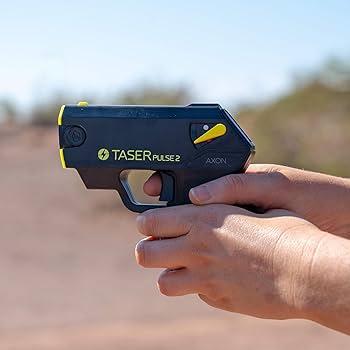Table of Contents
- Understanding the Electrical Mechanism of Stun Guns on Nerve Cells
- The Immediate Effects of Stun Gun Pulses on Central Nervous System Functions
- Long-Term Neurological Implications and Risks of Stun Gun Exposure
- Best Practices for Safe Use and Minimizing Neurological Harm
- To Conclude
Understanding the Electrical Mechanism of Stun Guns on Nerve Cells
At the core of a stun gun’s functionality lies its ability to deliver a high-voltage, low-current electrical charge that disrupts the normal signaling processes within nerve cells. When the electrical pulse from a stun gun reaches the skin, it penetrates the underlying tissue, targeting the peripheral nerves that act as communication highways between the muscles and the central nervous system. These pulses temporarily override the nerve cell’s standard electrical activity, causing an involuntary muscle contraction and interrupting the transmission of nerve signals to the brain. The result is a sudden state of neuromuscular incapacitation, which incapacitates the target briefly without causing permanent damage.
The interaction between the stun gun’s electrical output and nerve cells can be broken down into several key effects:
- Depolarization of nerve membranes: The electrical charge causes rapid shifts in ion concentrations across nerve membranes, which disrupts normal signal propagation.
- Interference with synaptic communication: The charge alters neurotransmitter release at nerve junctions, blurring or halting message transmission.
- Induced muscle contraction: The overstimulated nerves force muscles into involuntary contractions, leading to the characteristic immobilization.
This sophisticated electrical interference exploits the delicate electrochemical balance of nerve cells, demonstrating how technological design harnesses bioelectrical principles to create an effective yet non-lethal self-defense tool.
The Immediate Effects of Stun Gun Pulses on Central Nervous System Functions
When a stun gun discharges, it emits high-voltage pulses designed to disrupt the normal electrical signaling within the central nervous system (CNS). These pulses interfere primarily with the nerve signals that control muscle movement, causing immediate neuromuscular incapacitation. The rapid, intense electrical discharge can override voluntary commands from the brain, creating an involuntary muscle contraction that immobilizes the individual momentarily. This sudden disruption affects not only motor neurons but also sensory pathways, which contributes to the overwhelming sensation often reported by those struck by a stun gun.
Key immediate effects include:
- Neuromuscular blockade: The muscles receive chaotic signals, resulting in temporary paralysis or loss of muscle control.
- Nerve signal interference: Normal communication between the brain and body parts is interrupted, compromising coordinated movement.
- Short-term sensory disruption: Pain receptors and tactile sensation can be distorted, enhancing disorientation.
This rapid and targeted interference with CNS function is what makes stun guns effective for law enforcement in subduing subjects without lasting physical harm. However, the precise impact can vary, depending on the individual’s nervous system sensitivity and the pulse duration and intensity administered by the device.
Long-Term Neurological Implications and Risks of Stun Gun Exposure
Prolonged or repeated exposure to stun gun discharges can lead to subtle yet potentially serious neurological consequences. The electric shocks disrupt the normal electrical activity within the central nervous system (CNS), sometimes causing transient neuronal dysfunction. While immediate effects such as pain and muscle contraction are well-documented, the long-term impact on brain and spinal cord function remains an emerging area of research. Some studies suggest a heightened risk for conditions like persistent neuropathic pain, cognitive disturbances, or even increased vulnerability to seizures in individuals with predisposing factors.
Several factors influence the extent and severity of neurological risks, including:
- Voltage and duration of the stun gun exposure
- Frequency of repeated shocks over time
- Individual neurological health, including preexisting conditions
- Proximity of the shocks to the head or spine
Given these variables, medical experts recommend cautious use and thorough evaluation following significant stun gun encounters to prevent possible chronic impairments. Monitoring symptoms such as enduring numbness, memory issues, or motor difficulties can be crucial for timely intervention and mitigating lasting damage.
Best Practices for Safe Use and Minimizing Neurological Harm
Ensuring the safe use of stun guns requires strict adherence to guidelines that prioritize minimizing any potential neurological risks. Always aim for large muscle groups, such as the thigh or shoulder, to reduce the chance of directly affecting the central nervous system. Avoid targeting the head, neck, or spine, where nerve damage is more likely. Additionally, limiting exposure time is crucial; discharge the stun gun in short bursts rather than prolonged shocks to lessen the impact on neural tissue. Users should be trained thoroughly on device operation and understand the physiological effects to prevent accidental misuse.
- Maintain a safe distance to prevent unnecessary physical struggle or close contact.
- Inspect the device before use to ensure proper function and adequate charge.
- Use protective gear where possible to shield vulnerable areas like the face and neck.
- Keep stun gun use to lawful and appropriate situations, reducing unnecessary neurological trauma.
- Seek medical attention immediately if a shock results in prolonged unconsciousness, seizures, or severe pain.
To Conclude
In summary, stun guns deliver a targeted electrical shock that disrupts the normal functioning of the central nervous system, temporarily incapacitating the individual without causing permanent harm. Understanding this mechanism not only highlights the effectiveness of stun guns in self-defense and law enforcement but also underscores the importance of responsible use to ensure safety. As technology evolves, continued research will be vital in balancing functionality with human health considerations, making stun guns a fascinating intersection of science and public safety.Check Our Other Blogs
- StunGun – Your Trusted Source for Stun Guns, Laws, and Self-Defense Tips
- PepperSprayLaws – Your Trusted Resource for Pepper Spray Information
- StunGunLaws – Your Trusted Guide to Stun Gun Legality and Safety





